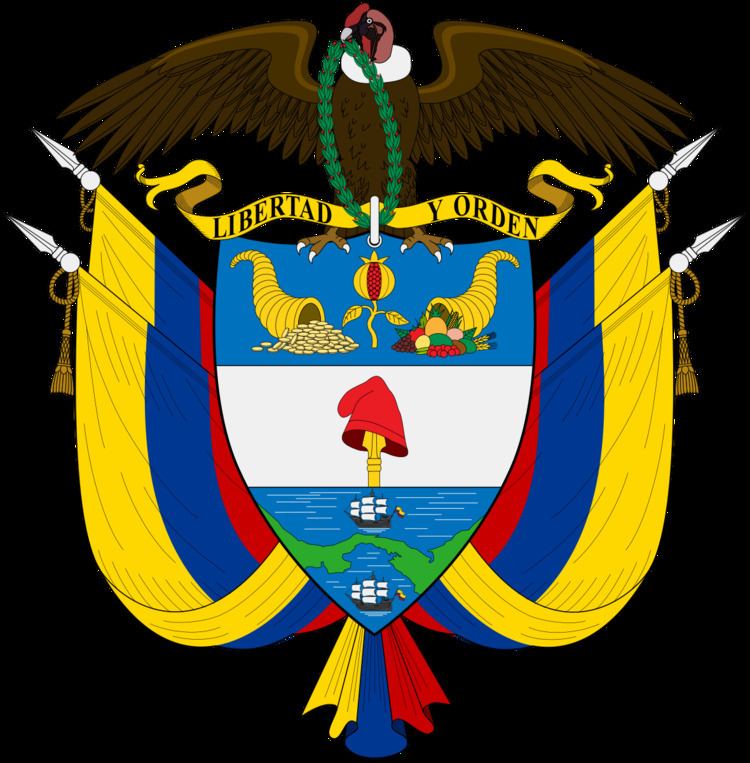The Council of Ministers of the Republic of Colombia is composed of the most senior appointed politicians of the executive branch of the Government of Colombia. Members of the Cabinet are generally the heads of a Ministry Department. The existence of the Cabinet dates back to the first President Simon Bolivar. These members were appointed in order to advise the President and are therefore required to assist him in his duties as stated by the Colombian Constitution.
The Cabinet of President Juan Manuel Santos.
In the Constitution of 1821, Simón Bolívar created a Cabinet composed of five secretariats:
Secretariat of the InteriorSecretariat of the ExteriorSecretariat of War and NavySecretariat of Finance and Public CreditWith time, areas of some secretariats were given to new institutions; in the mid-19th century when the Secretariat of Trade was created, depriving of that function to the Secretariat of the Exterior (then renamed to Foreign Affairs).
In 1886, President Rafael Núñez changed their nomenclature from secretariats to ministries, and created new ones, so, in the beginning of the 20th century, after the Thousand Days War, the Council of ministers was composed of:
Ministry of the GovernmentMinistry of JusticeMinistry of Foreign AffairsMinistry of WarMinistry of FinanceMinistry of the Treasury1894 - The Ministry of Justice is disbanded.The Secretary of Trade disappeared, its assignments were transferred to the Vice Ministry of Development, under the control of the Minister of Finance.
1990's1991 - The Ministry of Foreign Trade is created.1992 - The Ministry of Public Works and Transport is renamed Ministry of Transport.1993 - The Ministry of Justice is renamed Ministry of Justice and Law.1993 - The Ministry of Environment is created.1996 - The Ministry of Government is renamed the Ministry of the Interior.1997 - The Ministry of Culture is created.Ministries by the end of the 20th CenturyMinistry of the InteriorMinistry of Finance and Public CreditMinistry of Justice and LawMinistry of National DefenceMinistry of Health and Social SecurityMinistry of LabourMinistry of Agriculture and Rural DevelopmentMinistry of Foreign TradeMinistry of National EducationMinistry of Mines and EnergyMinistry of TransportMinistry of CommunicationsMinistry of EnvironmentMinistry of Economic DevelopmentMinistry of Culture2000'sDuring the first administration of President Álvaro Uribe, Congress and the President passed Law 790 of 2002, which modified the existing ministries by merging and reducing their number to 13. In accordance with Article 7, the Ministries in order and precedence were then thus:
Ministry of the Interior and JusticeMerging the Ministry of Justice and Law with the Ministry of the Interior.Ministry of Foreign AffairsMinistry of Finance and Public CreditMinistry of National DefenseMinistry of Agriculture and Rural DevelopmentMinistry of Social ProtectionMerging the Ministry of Labour and Social Security with the Ministry of Health.Ministry of Mines and EnergyMinistry of Commerce, Industry and TourismMerging the Ministry of Foreign Trade with the Ministry of Economic Development.Ministry of National EducationMinistry of Environment, Housing and Territorial DevelopmentThe Ministry of the Environment is enhanced and assigned matters of potable water, land use, sanitation, and rural development.Ministry of CommunicationsMinistry of TransportMinistry of Culture2009 - Passed on July 30, 2009, Law 1341 of 2009 redefined the Ministry of Communications and transformed it into the Ministry of Information Technologies and Communications.2010's2011 - The Ministry of the Interior and Justice is once again divided into the Ministry of the Interior and Ministry of Justice and Law.2011 - The Ministry of Environment, Housing and Territorial Development is divided into the Ministry of Environment and Sustainable Development and the Ministry of Housing, City and Territory.2011 - The Ministry of Social Protection is divided into the Ministry of Labour and the Ministry of Health and Social Protection.
